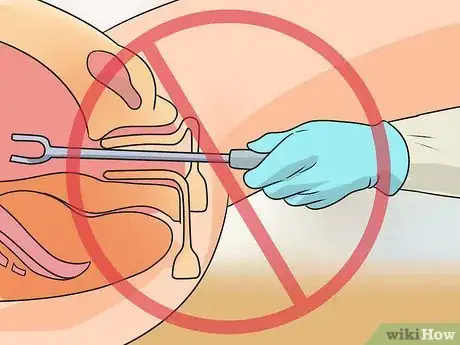This article was medically reviewed by Lacy Windham, MD. Lacy Windham, MD, is a Board-Certified Obstetrician & Gynecologist in Cleveland, Tennessee. Dr. Windham attended medical school at the University of Tennessee Health Science Center in Memphis. Her residency was completed at Eastern Virginia Medical School in Norfolk, Virginia. She was the recipient of multiple awards during her residency training, including Most Outstanding Resident in Maternal Fetal Medicine, Most Outstanding Resident in Oncology, Most Outstanding Resident Overall, and Special Award in Minimally Invasive Surgery.
There are 12 references cited in this article, which can be found at the bottom of the page.
This article has been viewed 122,432 times.
Studies show that in the United States, over 1 million pregnant women give birth through cesarean section (C-section) annually.[1] C-sections can resolve labors that may have medical complications, and can help to save the lives of mothers and babies due to an emergency during labor. But many experts believe that these surgeries are being performed too frequently, and sometimes for preventable reasons.[2] If you'd like to avoid the additional risks and extended recovery periods associated with C-sections, there are a few ways to improve your odds of having a vaginal birth during your pregnancy.
Steps
Finding the Right Pregnancy Care
-
1Consider using a certified midwife. Most women deliver their babies under the care of obstetricians, but studies show that midwives can be more successful at guiding laboring women through vaginal deliveries without unnecessary interventions, like a C-section. Before you use a midwife, confirm her credentials as a certified nurse-midwife (CNM). A CNM will have a bachelor's degree and/or a master's degree, will have completed nursing and midwifery training, and have passed exams to be certified and licensed as a midwife through their state of practice.[3]
- Midwives are not trained to perform surgery or handle high-risk deliveries, but most are affiliated with hospitals or obstetrical associations. Be aware that if you end up having complications when you go into labor, a midwife will have to transfer you into the care of an obstetrician. Talk about the possibilities of complications with your midwife well before your due date approaches and add instructions to your birth plan about what to do in the event of complications during labor.
- Ask your provider how often she performs episiotomies. This is when a surgical incision is made during the second trimester to enlarge the vaginal opening for the baby to pass through. This procedure is becoming less and less common, but you should ask the midwife if this is something she practices.
- Midwives generally do not instruments like forceps or vacuums, as they are usually not trained to use them, and they generally do not have the privileges to do so. Be aware that these devices can be lifesaving to mom and baby, and can often prevent the need for a cesarean.
- Their patients generally require less pain medication (though some midwives cannot administer drugs or anesthesia, which may impact how many of their patients use pain medication). After delivery, patients report being happier with their experience.
- If you have a high-risk pregnancy, such as expecting twins or multiples, or if you have gestational diabetes, high blood pressure, or chronic health problems, it is not advisable to work with a midwife without an obstetrician.
-
2Ask your obstetrician about her policy on C-sections. If you decide to go with an obstetrician rather than a midwife, make sure you choose one who respects your desire to have a vaginal birth. Ask about where she will deliver your baby: are you limited to a particular hospital, or do you have other options, including birth centers? More flexibility will give you more control over how you will deliver your baby.[4]
- Ask your obstetrician what her “primary cesarean rate” is. This number represents the percentage of first-time cesareans performed by your doctor. The number should be as low as possible, ideally around 15–20%.
Advertisement -
3Get a doula for additional support. Doulas are non medical professionals who can be hired to accompany you to your hospital or birth center and offer you extra assistance throughout your labor and delivery. They are not medical care providers, but their guidance and support can contribute to faster labors with fewer complications and lower rates of cesarean sections.[5]
- A recent study showed that many pregnant women do not know about the services provided by a doula and as a result, are not reaping the benefits of doula care. Ask your obstetrician to recommend a doula or ask other mothers if they can recommend a doula. Some birthing centers may offer doula assistance as part of your overall care at their facility.
- Keep in mind the services of a doula will likely not be covered by your health insurance and doula rates can range from several hundred to several thousand dollars.
-
4Take a natural birthing class. Get more information on how to prevent a C-section by taking a natural birthing class, which will focus on breathing techniques, and how to get through labor without any pain medication or intervention. You will learn how to manage your pain naturally through body positioning and breathing exercises, which can reduce your need for medical interventions, including a C-section.[6]
- If you are giving birth at a birthing center or a hospital, ask them for a referral to a natural birthing class. Your doula may also be able to recommend a birthing class, if you are using the services of a doula.
Adjusting Your Diet and Doing Exercise
-
1Eat a balanced and healthy diet during your pregnancy. Labor and delivery are physically demanding, and you need to be able to meet those challenges. Eating a healthy diet with plenty of protein, fruits, vegetables, and complex carbohydrates will help you be in the best shape possible when the time comes.[7]
- Obesity is one of the biggest risk factors for requiring a cesarean. Optimizing your health prior to pregnancy limiting weight gain through exercise and proper diet can help lower your chances of a cesarean.
- Maintain a well balanced diet that contains the four food groups: fruits and vegetables, protein, dairy and grains.[8]
- Make sure your daily diet consists of five portions of fresh or frozen fruit, six ounces or less of protein like meat, fish, eggs, soya, or tofu, three to four servings of fresh or frozen vegetables, six to eight servings of grains like bread, rice, pasta, and breakfast cereals, and two to three servings of dairy like yogurt and hard cheeses.[9]
- It is also important that you maintain a healthy weight for your age and body type. Avoid being underweight or overweight while pregnant, as this can lead to complications and health issues. You can calculate your Body Mass Index (BMI) using an online BMI calculator and determine how many calories per a day you should be consuming to maintain a healthy weight.
- If you are concerned about your diet, ask your doctor or midwife for specific advice. If you have gestational diabetes or other complications, you will need to follow additional, specific dietary guidelines.
-
2Exercise throughout your pregnancy. As long as your doctor or midwife approves, moderate exercise will also help you stay fit and ready to meet the demands of childbirth.[10]
- Do low impact exercises like swimming, walking, and yoga. You can also do targeted exercises made for pregnant women, such as ab exercises.
- Avoid exercises where you lie flat on your back after your first trimester, as well as contact sports, and activities that pose a risk of falling, such as skiing, surfing, and horseback riding.
-
3Get plenty of rest, especially during your last trimester. If you can go into labor as well-rested as possible, you will be more likely to handle the physical demands of childbirth without needing interventions. Most pregnant women need more sleep than they think, as their body is supporting a baby and may be more tired than usual.[11]
- It can be tricky to find a comfortable position to lie down while you are pregnant that will not endanger your baby. Try to lie down on your left side, with your legs bent. You can use a body pillow or several pillows on your lower back to sleep in comfort.
-
4Do prenatal yoga. Prenatal yoga has been shown to improve your sleep, reduce any stress or anxiety, and give your muscles more strength, flexibility, and endurance to have a smooth childbirth. It can also reduce your risk of preterm labor, and other labor related issues that could lead to an emergency C-section.[12]
- During a typical prenatal yoga class, you will learn breathing techniques, do gentle stretching, and do postures to strengthen your flexibility and balance. You will also be given a period at the end of the class to cool down and relax.
Avoiding Unnecessary Interventions During Labor
-
1Do not go to the hospital until you are in active labor. Showing up too early at the hospital, when you are still in the early stages of labor can lead to unnecessary interventions during labor, including a possible C-section.
- The first phase of labor is the longest, with mild contractions. Walking around, being on your feet, and squatting during this phase will help your labor continue in a healthy and normal fashion until you reach active labor. This phase of labor often occurs later than once thought by doctors, when your cervix is at least six centimeters dilated. Staying at home until you are in active labor and it is time for medical intervention can help to ensure a vaginal birth.
-
2Avoid being induced during labor. In some cases, labor induction, which when labor is brought on with drugs or instruments, is medically necessary. But as long as you and the baby are doing well during labor, it is best to avoid labor induction. Research has shown that induction during labor can double your likelihood of having a cesarean section.[13]
- Try to avoid an “elective induction,” which is an induction done purely for convenience, rather than necessity. Instead, lean on your birthing partner, your spouse, or your doula and use the breathing and labor techniques you learned in a birthing class to encourage labor.
-
3Ask your doctor about your pain management options. There is conflicting evidence for whether or not epidurals can increase your chance of a cesarean section. An epidural delivered too early in labor may increase your chances of C-section; however, a combined spinal epidural (CSE) or "walking" epidural offers pain relief without numbness and can actually make pushing easier.[14] Talk to your doctor or midwife about the relative benefits and risks of pain medications so you can decide which pain management option is right for you.
- An epidural can limit your baby's ability to move around in the womb, so if he is in a bad position he may have a hard time adjusting to a better position during labor. When you are given an epidural, your ability to move around will also be limited, which could lead to complications during labor.[15]
- You may be able to reduce some of the increased risk of needing a cesarean section by waiting until you are at least 5 centimeters (2.0 in) dilated before you get an epidural or other pain medication. By that point, your labor is less likely to slow down or stop. It can also help to stay mobile during the early stages of labor by walking around and shifting positions while you are in labor. Avoid laying flat on your back, as this can make it more difficult for your baby to get in a good labor position, and prolong your labor.[16]
-
4Learn how to turn a breech baby from your midwife or your obstetrician. A baby that is breech is positioned butt-first or feet-first in the womb and if not moved, can cause complications during delivery. If your baby is breech at about 36 weeks of pregnancy, your midwife or doctor can show you hands-to-belly movements to turn the baby so he is head first. These movements can reduce the need for a C-section by ensuring your baby in is a good position for labor.
- If your baby is a bad position during labor and may have a hard time passing through your pelvis despite hand movements to shift him, your obstetrician may use forceps or a vacuum extractor as a safe alternative to a C-section. Talk to your obstetrician about these procedures and specify in your birth plan if you would prefer these options to a cesarean section.
-
5Let your birth partner know about your desire for a vaginal birth. If you have requested that your spouse or birth partner be with you in the delivery room, make sure that person knows that you want a vaginal delivery. He or she can support you through your contractions, remind you of your goals, and speak up for you when you are too exhausted to do so effectively.[17]
- You should also specify in your birth plan that you would like a vaginal birth and give your obstetrician, your midwife, and your doula a copy of your birth plan. However, it's important that expectant mothers always include a provision in their birth plan about what to do in the event a C-section is needed due to emergency medical reasons.
References
- ↑ https://www.cdc.gov/nchs/fastats/delivery.htm
- ↑ https://www.cdc.gov/nchs/data/nvsr/nvsr63/nvsr63_01.pdf
- ↑ http://kidshealth.org/parent/pregnancy_center/childbirth/midwives.html
- ↑ http://americanpregnancy.org/labor-and-birth/avoid-cesarean/
- ↑ http://www.cochrane.org/CD003766/PREG_continuous-support-for-women-during-childbirth
- ↑ http://americanpregnancy.org/labor-and-birth/avoid-cesarean/
- ↑ http://kidshealth.org/parent/pregnancy_center/your_pregnancy/preg_health.html#
- ↑ http://www.heart.org/HEARTORG/GettingHealthy/NutritionCenter/HealthyEating/Suggested-Servings-from-Each-Food-Group_UCM_318186_Article.jsp
- ↑ http://www.heart.org/HEARTORG/GettingHealthy/NutritionCenter/HealthyEating/Suggested-Servings-from-Each-Food-Group_UCM_318186_Article.jsp
- ↑ https://www.betterhealth.vic.gov.au/health/healthyliving/pregnancy-and-exercise
- ↑ https://www.hopkinsmedicine.org/health/conditions-and-diseases/staying-healthy-during-pregnancy/get-a-good-nights-sleep-during-pregnancy
- ↑ https://bmcpregnancychildbirth.biomedcentral.com/articles/10.1186/s12884-021-03794-6
- ↑ https://onlinelibrary.wiley.com/doi/10.1111/jmwh.13174
- ↑ https://onlinelibrary.wiley.com/doi/10.1111/jmwh.13174
- ↑ https://www.ncbi.nlm.nih.gov/pmc/articles/PMC4235054/
- ↑ https://onlinelibrary.wiley.com/doi/10.1111/jmwh.13174
- ↑ http://americanpregnancy.org/labor-and-birth/avoid-cesarean/











































































Medical Disclaimer
The content of this article is not intended to be a substitute for professional medical advice, examination, diagnosis, or treatment. You should always contact your doctor or other qualified healthcare professional before starting, changing, or stopping any kind of health treatment.
Read More...